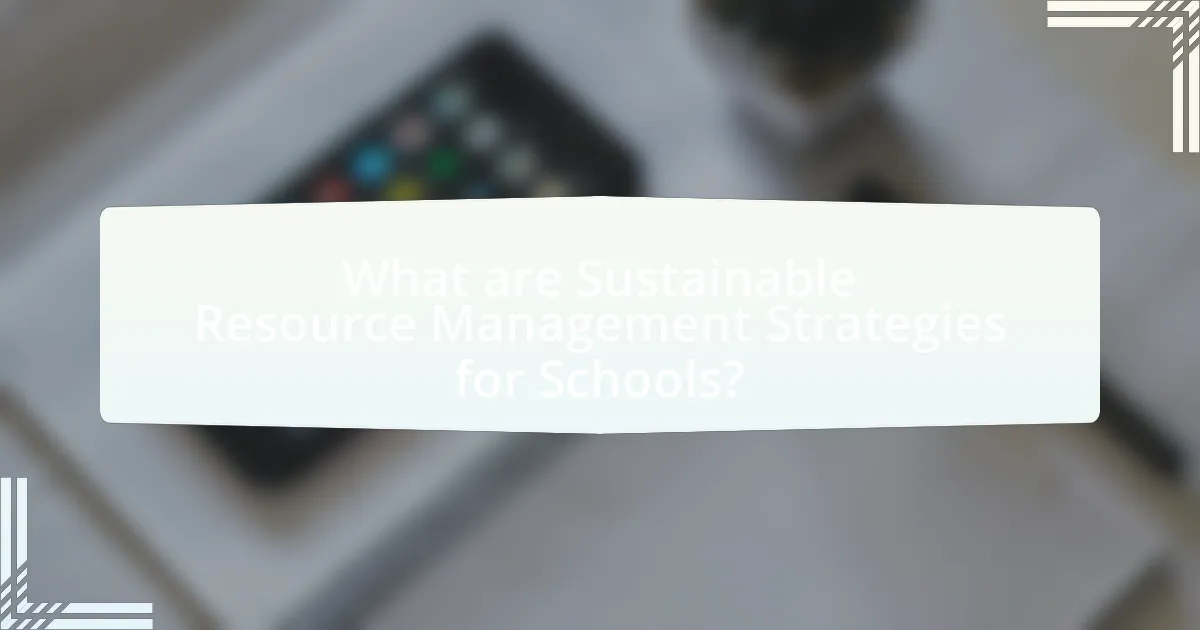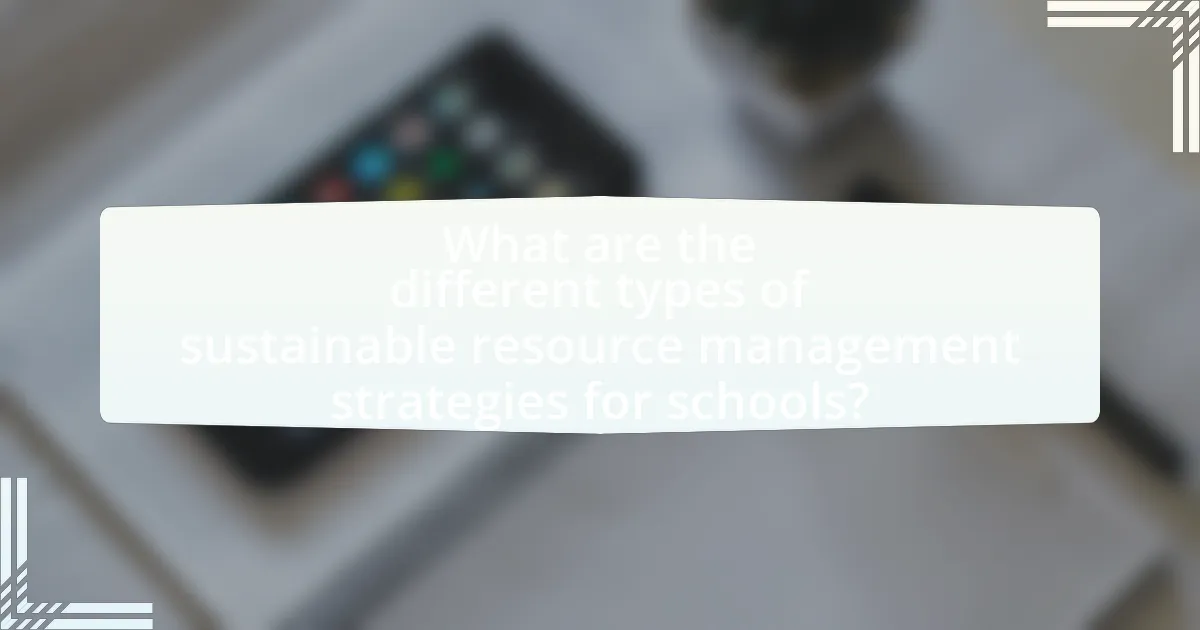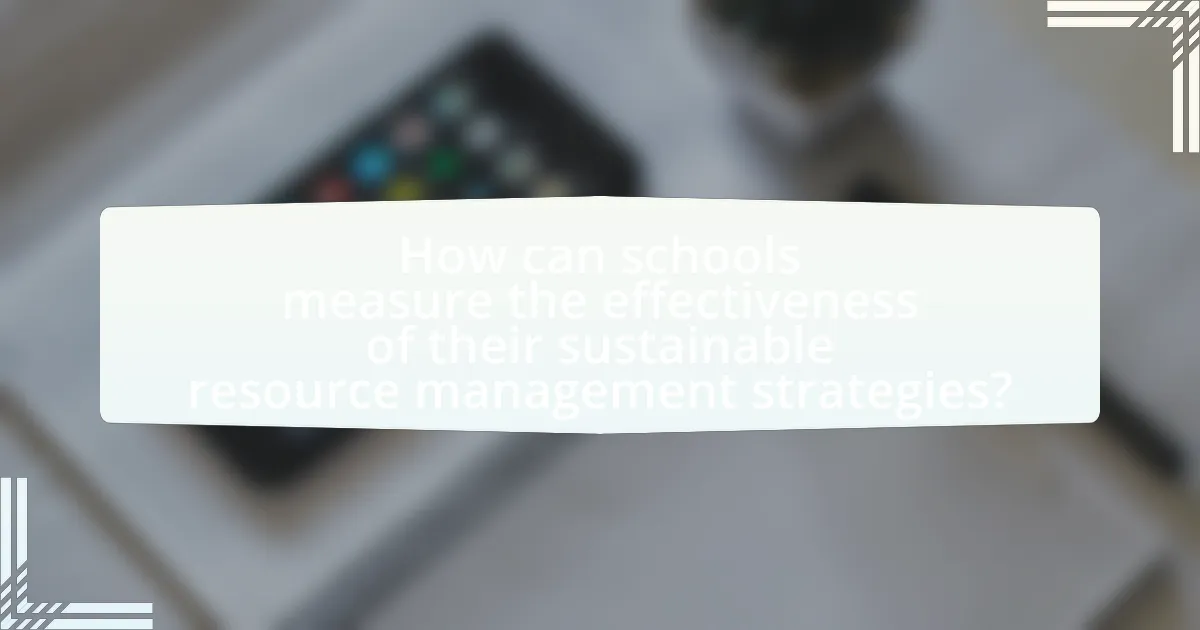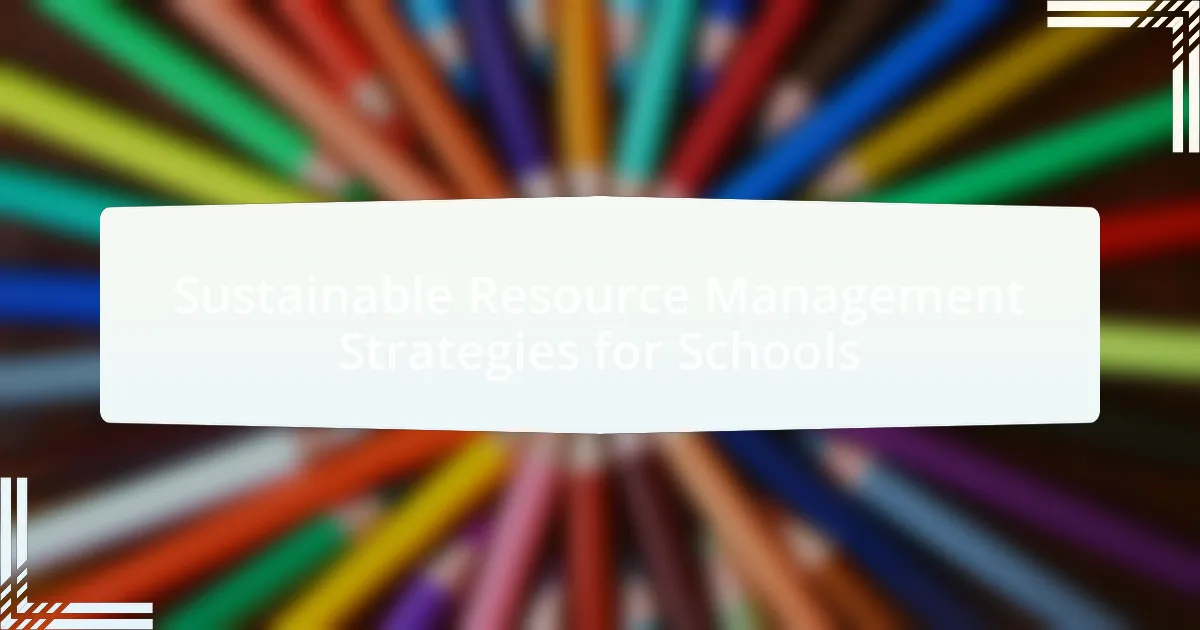Sustainable resource management strategies for schools focus on implementing practices that enhance energy efficiency, promote waste reduction, and integrate sustainability into educational curricula. Key strategies include utilizing energy-efficient technologies, establishing comprehensive recycling and composting programs, and engaging the school community in sustainability initiatives. These practices not only contribute to environmental sustainability by reducing waste and conserving resources but also lead to significant operational cost savings for educational institutions. The article outlines the principles of sustainable resource management, the impact on student learning, and effective methods for measuring and improving sustainability efforts within schools.

What are Sustainable Resource Management Strategies for Schools?
Sustainable resource management strategies for schools include implementing energy efficiency measures, promoting waste reduction and recycling programs, and integrating sustainable practices into the curriculum. Energy efficiency measures, such as using LED lighting and energy-efficient appliances, can reduce energy consumption by up to 30%, as reported by the U.S. Department of Energy. Waste reduction strategies, including composting and recycling, can divert significant amounts of waste from landfills; for instance, schools that adopt comprehensive recycling programs can achieve recycling rates of 50% or higher. Additionally, incorporating sustainability into the curriculum fosters environmental awareness among students, preparing them to engage in responsible resource management in the future.
How do these strategies contribute to environmental sustainability?
Sustainable resource management strategies for schools contribute to environmental sustainability by reducing waste, conserving energy, and promoting biodiversity. These strategies, such as implementing recycling programs, utilizing renewable energy sources, and incorporating green spaces, directly minimize the ecological footprint of educational institutions. For instance, schools that adopt solar panels can decrease their reliance on fossil fuels, leading to a reduction in greenhouse gas emissions. Additionally, schools that engage in composting and recycling can divert significant amounts of waste from landfills, with studies indicating that recycling can reduce waste by up to 75%. Furthermore, creating green spaces enhances local biodiversity, providing habitats for various species and improving air quality. These concrete actions collectively support the overarching goal of environmental sustainability by fostering a more responsible and eco-friendly approach to resource management in educational settings.
What are the key principles of sustainable resource management in educational settings?
The key principles of sustainable resource management in educational settings include efficiency, conservation, and community engagement. Efficiency focuses on optimizing resource use, such as energy and water, to minimize waste and reduce costs. Conservation emphasizes protecting natural resources through practices like recycling and sustainable procurement. Community engagement involves involving students, staff, and local stakeholders in sustainability initiatives, fostering a culture of environmental responsibility. These principles are supported by research indicating that schools implementing sustainable practices can reduce operational costs by up to 30% while enhancing educational outcomes and community awareness.
How do these principles apply to daily operations in schools?
Sustainable resource management principles apply to daily operations in schools by promoting efficient use of resources, reducing waste, and enhancing environmental stewardship. Schools implement these principles through practices such as energy-efficient lighting, water conservation measures, and recycling programs. For instance, the U.S. Environmental Protection Agency reports that schools can save up to 30% on energy costs by adopting energy-efficient technologies. Additionally, integrating sustainability into the curriculum fosters awareness among students, encouraging them to participate in resource conservation efforts. This holistic approach not only minimizes environmental impact but also cultivates a culture of sustainability within the school community.
Why is sustainable resource management important for schools?
Sustainable resource management is important for schools because it promotes environmental stewardship and reduces operational costs. By implementing practices such as energy efficiency, waste reduction, and water conservation, schools can significantly lower their utility bills and resource consumption. For instance, a study by the U.S. Green Building Council found that green schools can save up to 30% on energy costs compared to traditional schools. Additionally, sustainable practices enhance the learning environment, fostering a culture of responsibility among students and staff. This not only prepares students for future challenges related to sustainability but also contributes to the overall well-being of the community.
What impact does resource management have on student learning and engagement?
Resource management significantly enhances student learning and engagement by ensuring that educational resources are allocated efficiently and effectively. When schools implement sustainable resource management strategies, they can provide better access to learning materials, technology, and facilities, which directly supports student achievement. For instance, a study by the National Center for Education Statistics found that schools with well-managed resources reported higher student engagement levels and improved academic performance. This correlation indicates that effective resource management not only optimizes the use of available assets but also fosters an environment conducive to learning, thereby positively impacting student outcomes.
How can effective resource management reduce operational costs for schools?
Effective resource management can significantly reduce operational costs for schools by optimizing the use of financial, human, and physical resources. By implementing strategies such as energy efficiency programs, schools can lower utility bills; for instance, a study by the U.S. Department of Energy found that energy-efficient upgrades can reduce energy costs by 20-50%. Additionally, effective scheduling and staffing can minimize overtime and maximize teacher utilization, leading to reduced payroll expenses. Furthermore, resource-sharing initiatives among schools can decrease procurement costs, as bulk purchasing often results in discounts. These practices collectively contribute to a more sustainable financial model for educational institutions.

What are the different types of sustainable resource management strategies for schools?
Sustainable resource management strategies for schools include energy efficiency, water conservation, waste reduction, and sustainable procurement. Energy efficiency strategies involve upgrading to LED lighting and optimizing heating and cooling systems, which can reduce energy consumption by up to 30% according to the U.S. Department of Energy. Water conservation techniques, such as installing low-flow fixtures and rainwater harvesting systems, can decrease water usage significantly, with some schools reporting reductions of over 50%. Waste reduction strategies, including recycling programs and composting, help divert waste from landfills, with schools achieving up to 75% waste diversion rates. Sustainable procurement focuses on purchasing eco-friendly products and materials, which supports local economies and reduces environmental impact. These strategies collectively contribute to a more sustainable school environment and promote environmental stewardship among students.
How can schools implement energy-efficient practices?
Schools can implement energy-efficient practices by conducting energy audits to identify areas for improvement and adopting renewable energy sources such as solar panels. Energy audits help schools assess their current energy consumption and pinpoint inefficiencies, leading to targeted upgrades like better insulation, energy-efficient lighting, and HVAC systems. According to the U.S. Department of Energy, schools that implement energy-efficient measures can reduce energy costs by 20-50%, demonstrating the financial and environmental benefits of such practices.
What technologies can schools adopt to enhance energy efficiency?
Schools can adopt technologies such as smart thermostats, energy-efficient lighting, and solar panels to enhance energy efficiency. Smart thermostats optimize heating and cooling by learning occupancy patterns, which can reduce energy consumption by up to 10-15%, according to the U.S. Department of Energy. Energy-efficient lighting, such as LED bulbs, uses at least 75% less energy than traditional incandescent bulbs and lasts significantly longer, leading to reduced electricity costs. Additionally, solar panels can generate renewable energy on-site, potentially covering a significant portion of a school’s energy needs, with studies showing that schools can save thousands of dollars annually on energy bills by utilizing solar energy systems.
How can schools promote energy conservation among students and staff?
Schools can promote energy conservation among students and staff by implementing educational programs that raise awareness about energy usage and its environmental impact. These programs can include workshops, interactive lessons, and campaigns that encourage students and staff to adopt energy-saving practices, such as turning off lights and unplugging devices when not in use. Research indicates that schools that engage students in energy conservation initiatives can reduce energy consumption by up to 20%, demonstrating the effectiveness of such educational efforts. Additionally, schools can establish energy monitoring systems to track usage and provide feedback, fostering a culture of accountability and responsibility towards energy conservation.
What role does waste management play in sustainable resource strategies?
Waste management is crucial in sustainable resource strategies as it minimizes environmental impact and promotes resource recovery. Effective waste management practices, such as recycling and composting, reduce landfill use and conserve natural resources. For instance, the U.S. Environmental Protection Agency reports that recycling and composting prevented the release of 186 million metric tons of carbon dioxide equivalent into the air in 2013, demonstrating the significant environmental benefits of proper waste management. By integrating waste management into sustainable resource strategies, schools can enhance their sustainability efforts, reduce costs, and educate students on responsible resource use.
How can schools reduce, reuse, and recycle effectively?
Schools can reduce, reuse, and recycle effectively by implementing comprehensive waste management programs that include education, infrastructure, and community involvement. To reduce waste, schools can adopt practices such as minimizing paper use through digital assignments and promoting the use of reusable materials like water bottles and lunch containers. Reusing items can be encouraged through initiatives like book swaps and supply exchanges, which foster a culture of sharing among students and staff. Recycling can be enhanced by providing clearly labeled recycling bins throughout the campus and conducting regular workshops to educate students about proper recycling practices. According to the U.S. Environmental Protection Agency, schools that implement these strategies can significantly decrease waste, with some institutions reporting reductions of up to 50% in landfill contributions.
What are the benefits of composting programs in schools?
Composting programs in schools provide significant environmental, educational, and community benefits. Environmentally, these programs reduce waste sent to landfills, with composting diverting approximately 30% of organic waste, thus lowering greenhouse gas emissions. Educationally, they enhance students’ understanding of sustainability and ecology, fostering a sense of responsibility towards the environment. Community-wise, composting initiatives can strengthen school-community ties by involving local stakeholders in the process, promoting collaboration and awareness about waste management practices.

How can schools measure the effectiveness of their sustainable resource management strategies?
Schools can measure the effectiveness of their sustainable resource management strategies by tracking key performance indicators (KPIs) such as energy consumption, water usage, waste reduction, and cost savings. For instance, a study by the U.S. Green Building Council found that schools implementing energy-efficient practices reduced energy costs by 30% on average. Additionally, schools can conduct surveys to assess community and student engagement in sustainability initiatives, which can provide qualitative data on the impact of these strategies. Regular audits and assessments can also help in evaluating the progress and areas for improvement in resource management practices.
What metrics should schools use to evaluate sustainability efforts?
Schools should use metrics such as energy consumption, water usage, waste generation, and carbon footprint to evaluate sustainability efforts. Energy consumption metrics can include total kilowatt-hours used and percentage reduction over time, which helps assess efficiency improvements. Water usage metrics can track gallons used per student or per square foot of building space, providing insights into conservation efforts. Waste generation metrics, such as the amount of waste diverted from landfills through recycling and composting programs, indicate the effectiveness of waste management strategies. Finally, calculating the carbon footprint, which encompasses emissions from energy use, transportation, and waste, allows schools to understand their overall environmental impact. These metrics provide concrete data that schools can analyze to measure progress and identify areas for improvement in their sustainability initiatives.
How can schools track energy consumption and waste production?
Schools can track energy consumption and waste production by implementing smart metering systems and waste auditing processes. Smart meters provide real-time data on energy usage, allowing schools to monitor consumption patterns and identify areas for improvement. For waste production, conducting regular waste audits helps schools quantify the amount and types of waste generated, enabling them to develop targeted reduction strategies. Research indicates that schools using these methods can reduce energy consumption by up to 20% and waste production by 30%, demonstrating the effectiveness of these tracking systems in promoting sustainability.
What tools are available for assessing the impact of sustainability initiatives?
Tools available for assessing the impact of sustainability initiatives include Life Cycle Assessment (LCA), Sustainability Assessment Frameworks, and Environmental Impact Assessments (EIA). Life Cycle Assessment evaluates the environmental impacts of a product or service throughout its life cycle, providing quantitative data that helps schools understand resource use and emissions. Sustainability Assessment Frameworks, such as the Global Reporting Initiative (GRI), offer structured approaches for measuring sustainability performance across various indicators. Environmental Impact Assessments systematically evaluate the potential environmental effects of proposed projects, ensuring that sustainability initiatives align with ecological standards. These tools are widely recognized in sustainability research and practice, providing concrete methodologies for schools to measure and improve their sustainability efforts.
What are some best practices for schools to enhance their sustainability efforts?
Schools can enhance their sustainability efforts by implementing comprehensive recycling programs, utilizing renewable energy sources, and integrating sustainability into the curriculum. Comprehensive recycling programs can significantly reduce waste; for instance, schools that adopt such programs often see a reduction in landfill waste by up to 30%. Utilizing renewable energy sources, such as solar panels, can decrease energy costs and carbon footprints; schools that have installed solar energy systems report savings of 20-30% on energy bills. Additionally, integrating sustainability into the curriculum fosters environmental awareness among students, preparing them to be responsible citizens; studies show that schools with sustainability-focused education programs increase student engagement and knowledge in environmental issues by over 50%.
How can schools engage the community in sustainability initiatives?
Schools can engage the community in sustainability initiatives by organizing collaborative projects that involve students, parents, and local organizations. For example, schools can host community clean-up days, tree planting events, or recycling drives, which not only promote environmental stewardship but also foster a sense of community ownership and responsibility. Research indicates that community involvement in school-led sustainability efforts can enhance educational outcomes and increase local support for environmental initiatives, as seen in programs like the Green Schools Initiative, which reported a 30% increase in community participation when schools actively involved local stakeholders.
What resources are available for schools seeking to improve their sustainability practices?
Schools seeking to improve their sustainability practices can access various resources, including government grants, educational programs, and partnerships with environmental organizations. For instance, the U.S. Environmental Protection Agency offers the Green Schools Program, which provides tools and resources to help schools implement sustainable practices. Additionally, organizations like the National Wildlife Federation offer the Eco-Schools USA program, which guides schools in creating sustainable environments through curriculum integration and community involvement. These resources are designed to support schools in reducing their environmental impact and fostering a culture of sustainability among students and staff.

Leave a Reply